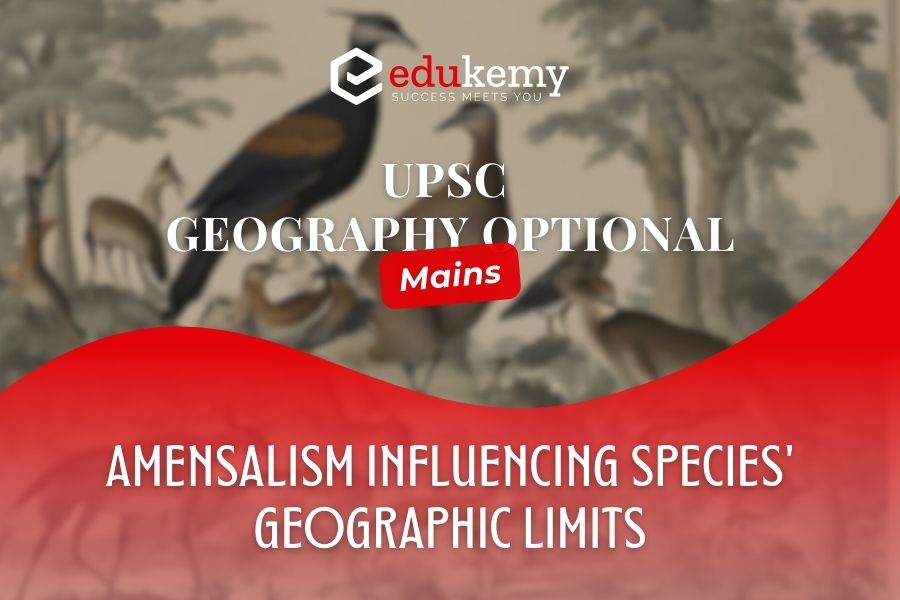
Delve into the ecological concept of amensalism and its role in delineating the geographical boundaries of species. Amensalism, a form of interspecies interaction, involves one organism inhibiting another without experiencing any benefit or harm itself. This phenomenon influences species distribution by creating unfavorable conditions for certain organisms, thus shaping their geographic range. Through amensalistic interactions, organisms may face constraints on their expansion into specific territories, impacting their ability to thrive in certain environments. Understanding the interplay between amensalism and species distribution sheds light on the intricate dynamics of ecosystems and the factors influencing biodiversity patterns across geographical landscapes. Explore the significance of amensalism in determining the geographic limits of species, unraveling its implications for ecological processes and community structure.
Contents
Answer:
Introduction:
Amensalism is a type of ecological interaction where one organism is negatively affected, while the other remains unaffected. It’s characterized by one organism releasing toxins or other harmful substances that inhibit the growth or survival of another organism. This interaction plays a crucial role in shaping the geographic limits of species.
Body:
- Competition for Resources: Amensalism can limit the geographic range of a species by intensifying competition for resources.
- For example, the black walnut tree releases juglone, a chemical that inhibits the growth of many other plant species. This restricts the distribution of susceptible plants in areas where black walnut trees dominate.
- Soil Bacteria and Plant Growth: Certain soil bacteria produce antibiotics that inhibit the growth of nearby plants.
- This amensalistic interaction can influence the composition of plant communities and restrict the distribution of susceptible plant species to areas where such bacteria are less prevalent.
- Allelopathy: Allelopathy is a form of amensalism where one plant species releases biochemicals that inhibit the growth of other plants.
- For instance, the invasive species Centaurea maculosa releases allelopathic compounds that suppress the growth of native plant species, contributing to its dominance and restricting the distribution of native plants.
- Microbial Amensalism: Microbial interactions can also determine species distribution.
- For example, certain fungi produce antibiotics that inhibit the growth of competing microbial species, influencing the composition of microbial communities and indirectly impacting the distribution of other organisms dependent on those microbes.
- Predator-Prey Dynamics: In some cases, amensalism can indirectly affect predator-prey relationships, thereby influencing species distribution.
- For instance, if a predator relies on a prey species that is inhibited by allelopathic substances released by another organism, the distribution of both predator and prey may be limited by the presence of the amensalistic organism.
- Aquatic Systems: In aquatic ecosystems, certain algae produce toxins that inhibit the growth of other organisms, including fish and invertebrates.
- This can restrict the distribution of susceptible species to areas where toxin-producing algae are less prevalent, shaping the geographic limits of aquatic species.
Conclusion:
As ecosystems continue to face anthropogenic pressures and climate change, understanding the role of amensalism in shaping species distribution is essential for effective conservation and management strategies. By recognizing the intricate interactions between organisms and their environment, we can better predict and mitigate the impacts of amensalistic interactions on species’ geographic limits, ultimately contributing to the preservation of biodiversity
In case you still have your doubts, contact us on 9811333901.
For UPSC Prelims Resources, Click here
For Daily Updates and Study Material:
Join our Telegram Channel – Edukemy for IAS
- 1. Learn through Videos – here
- 2. Be Exam Ready by Practicing Daily MCQs – here
- 3. Daily Newsletter – Get all your Current Affairs Covered – here
- 4. Mains Answer Writing Practice – here

